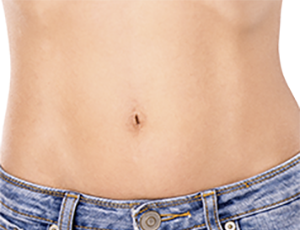
Tummy Tuck (Abdominoplasty)
What is a tummy tuck?
After pregnancies, weight loss, or with age, the abdominal skin may become loose, excessive or hang over clothing (apron or pannus of skin and fatty tissue). Many people will feel an abdominal bulge or prominence from a weakening or separation of underlying muscles of the abdominal wall (a rectus diastasis). Even without excessive or loose skin, this can lead to a bulging or prominent abdomen with poor contour.An abdominoplasty, or “tummy tuck”, is the surgical procedure to reshape and tighten the abdomen by excising the excess skin and fat, tightening the underlying muscles and using liposuction to improve the contour of the hips/flanks. The pubic area (mons pubis) is lifted and often thinned with liposuction when required.
Tummy tucks are a common procedure, particularly in patients who have had children. It is a day surgery only (no overnight is needed) and the recovery can be as short as 1-2 weeks.
Pre Surgery Instructions
Before the procedure
No aspirin or blood thinning medications for two weeks prior to surgery. Fasting begins at midnight the night before surgery. Any medications that you take in the AM may be taken with a sip of water (except for blood thinning medications). If you get ill prior to surgery please notify us.The Surgery
During the procedure
Performed under general anesthetic (nothing to eat or drink after midnight) a tummy tuck (abdominoplasty) takes approx. 2.5-3 hours and is a day surgery (there is no overnight stay). On the morning of surgery, Dr. Eckhaus makes all the markings on the abdomen and flanks in the pre operative area.The final scars are placed along the lower abdominal crease and are often hidden by underwear, clothes and bathing suits. The other scar is around the belly button (umbilicus), although some modified techniques will avoid this scar (mini tummy tuck or floating umbilicus tummy tuck). Only dissolvable sutures are used and a compression garment is applied at the end of the procedure. There are no drains used.
After Your Surgery
Post procedure
While In Hospital or Clinic
You will be in the recovery room anywhere from 1-3 hours where the team will ensure you are comfortable, eating and drinking, walking and able to urinate.
On discharge home
Immediately upon discharge from the recovery room, you are encouraged to rest under supervision and start a light diet as tolerated.
You will have been given a prescription for antibiotics that is started when you return home from surgery and is taken for 1 week.
The best position when lying down is with 2-3 pillows behind your head and 1 pillow under your knees.
You will have been given a prescription for antibiotics that is started when you return home from surgery and is taken for 1 week.
The best position when lying down is with 2-3 pillows behind your head and 1 pillow under your knees.
Day 1
You should be up and walking, drinking fluids, taking your antibiotics and pain medication as described below. Increase activity as tolerated, but there is no heavy lifting for 4 weeks. Leave the dressings alone. Many patients feel more comfortable walking slightly hunched over, which is fine, but not necessary.
What do I take for pain?
If you have pain, you are encouraged to start with:
Two Tylenol extra strength (total of 1000 mg of Tylenol) and one Advil extra strength (400 mg of Advil) to be taken at the same time as they work by different mechanisms and work very well together.
You can take the above three pills (two Tylenol extra strength and one Advil extra strength) every 8 hours around the clock for the first day or two. This is often sufficient for pain medication and can avoid the need for stronger medications such as narcotics (Percocet, Tylenol #3 etc.).
However, you will also have a prescription for a stronger pain medication that can be taken as needed if the Tylenol and Advil combination mentioned above does not suffice. This stronger pain medication may be taken on top of the above regimen. Please ensure the maximum dose of Tylenol in 24 hours does not exceed 4000 mg.
** Please be aware that with any medication and particularly Advil (a type of non-steroidal anti-inflammatory) there are risks of allergy, severe allergy, gastro-intestinal bleeding and stomach ulcers. Taking your medication with food can sometimes help with some of the stomach symptoms.
A post-operative compression wrap and the underlying gauze dressings are left in place for 2-4 days. During this period of time, you may use a hand held shower or sponge bath but the dressings must stay dry.
Two Tylenol extra strength (total of 1000 mg of Tylenol) and one Advil extra strength (400 mg of Advil) to be taken at the same time as they work by different mechanisms and work very well together.
You can take the above three pills (two Tylenol extra strength and one Advil extra strength) every 8 hours around the clock for the first day or two. This is often sufficient for pain medication and can avoid the need for stronger medications such as narcotics (Percocet, Tylenol #3 etc.).
However, you will also have a prescription for a stronger pain medication that can be taken as needed if the Tylenol and Advil combination mentioned above does not suffice. This stronger pain medication may be taken on top of the above regimen. Please ensure the maximum dose of Tylenol in 24 hours does not exceed 4000 mg.
** Please be aware that with any medication and particularly Advil (a type of non-steroidal anti-inflammatory) there are risks of allergy, severe allergy, gastro-intestinal bleeding and stomach ulcers. Taking your medication with food can sometimes help with some of the stomach symptoms.
A post-operative compression wrap and the underlying gauze dressings are left in place for 2-4 days. During this period of time, you may use a hand held shower or sponge bath but the dressings must stay dry.
First post-operative appointment
The initial dressing change is done on day 2-4 after surgery. The gauze is removed and the white skin tapes are left on. Dry gauze or padding can be used daily to protect the tapes from the compression garment. You will use a small amount of polysporin or fucidin and gauze for the belly button (umbilicus).
The compression garment/wrap is worn day and night for 4 weeks (except in the shower). You will be given two garments so that they can be alternated and washed.
The compression garment/wrap is worn day and night for 4 weeks (except in the shower). You will be given two garments so that they can be alternated and washed.
Second post-operative appointment
The second appointment is close to 2 weeks after surgery and the white skin will be removed and changed to new skin tapes. Dry gauze is no longer needed. The belly dressing is no longer needed and a post-operative marble or bead is often used to help with swelling of the umbilicus.
Post-operative swelling and bruising begins to subside after 7-10 days but can take up to 2-4 weeks for the initial 70% of swelling to resolve.
As swelling can persist for 6 months, it will take that long to see the final results particularly where liposuction has been used.
Patients usually require 1-2 weeks of downtime and should avoid strenuous exercise for 4-6 weeks.
Post-operative swelling and bruising begins to subside after 7-10 days but can take up to 2-4 weeks for the initial 70% of swelling to resolve.
As swelling can persist for 6 months, it will take that long to see the final results particularly where liposuction has been used.
Patients usually require 1-2 weeks of downtime and should avoid strenuous exercise for 4-6 weeks.
Third post-operative appointment:
The third appointment is close to 4 weeks following surgery. The second set of skin tapes that were placed at the prior visit are now all removed and left open to dry for 4-5 days before silicone gel sheeting is used for scar management (you will get this from the office).
The compression garment is no longer needed but can be used if you like, particularly for exercise or activity.
The scars will take 12-18 months to fully mature and fade. Silicone gel sheeting is the best product to help with scar maturation and is used for 2-3 months following surgery.
The compression garment is no longer needed but can be used if you like, particularly for exercise or activity.
The scars will take 12-18 months to fully mature and fade. Silicone gel sheeting is the best product to help with scar maturation and is used for 2-3 months following surgery.


